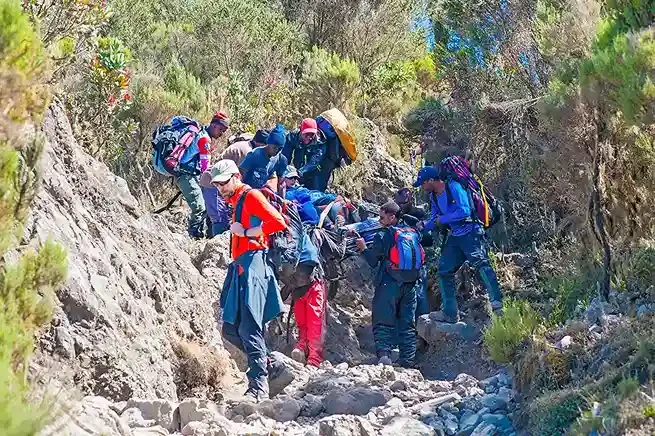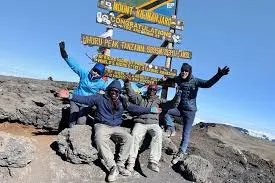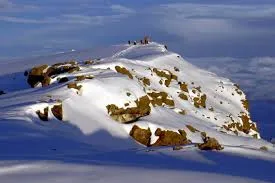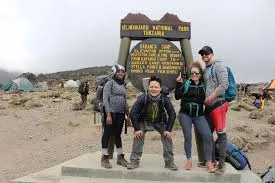Emergency Procedures While Climbing Kilimanjaro: Safety Guide
Emergency situations on Kilimanjaro can happen, so being prepared is key. Always climb with a licensed guide trained in first aid, and don’t ignore early signs of altitude sickness—descent is the safest treatment. Know evacuation routes, where rescue teams operate, and keep emergency contacts handy. Carry essential items like a whistle, headlamp, and basic first-aid kit, but trust your guide’s judgment if a serious situation arises. Safety always comes before summiting. Our experienced guides carry first aid kits, oxygen, and communication devices to ensure your safety on this 6–9 day trek through Kilimanjaro’s diverse climates. Be prepared, stay safe, and conquer the summit with confidence.
Plan Your Safe Kilimanjaro Trek Now
Why Emergency Preparedness is Critical for Kilimanjaro
Emergency preparedness is critical for Kilimanjaro because the mountain’s extreme altitude, unpredictable weather, and remote setting can quickly turn minor issues into life-threatening situations. Being prepared with the right knowledge, gear, and support ensures you can handle challenges like altitude sickness, sudden storms, or injuries safely—and gives you the confidence to focus on the climb itself. Capable Africa Tours prioritizes safety with trained guides, comprehensive first aid kits, and evacuation plans. This guide details key emergency procedures to ensure you’re ready for a safe 6–9 day trek.
Common Emergencies on Kilimanjaro
| Emergency Type | Symptoms | Response | Frequency (% of Climbers) |
|---|---|---|---|
| Acute Mountain Sickness (AMS) | Headache, nausea, dizziness | Rest, hydrate, oxygen, descent if severe | 50–75% |
| High Altitude Pulmonary Edema (HAPE) | Shortness of breath, coughing | Oxygen, immediate descent, medical attention | 1–2% |
| High Altitude Cerebral Edema (HACE) | Confusion, loss of coordination | Immediate descent, oxygen, medical evacuation | 0.5–1% |
| Minor Injuries | Sprains, blisters, cuts | First aid, stabilization, possible evacuation | 10–15% |
| Hypothermia | Shivering, confusion, fatigue | Warm layers, hot drinks, shelter, descent | 2–5% |
Emergency Procedures Checklist
- Monitor Symptoms: Regularly check for signs of altitude sickness using pulse oximeters (carried by Capable Africa Tours’ guides).
- Communicate: Report any discomfort to your guide immediately for early intervention.
- Hydrate and Rest: Drink 3–4 liters of water daily and follow the “pole pole” (slowly) pace to aid acclimatization.
- Use Oxygen: Supplemental oxygen is available for severe AMS cases to stabilize climbers.
- Prepare for Evacuation: Know your route’s evacuation points (e.g., ranger posts on Marangu or Machame routes).
- Carry Medications: Bring Diamox (consult a doctor) and inform guides of all medications.
- Weather Preparedness: Wear waterproof Gore-Tex layers and carry emergency blankets for sudden weather changes.
How Capable Africa Tours Ensures Your Safety
At Capable Africa Tours, safety is our top priority. Our guides are trained in wilderness first aid and high-altitude medicine, carrying essential equipment like pulse oximeters, oxygen cylinders, and satellite phones. We use longer routes like Lemosho or Machame for better acclimatization, reducing emergency risks. Here’s how we prepare for and manage emergencies on Kilimanjaro.
Safety Protocols
- Daily Health Checks: Guides monitor oxygen levels and symptoms twice daily.
- Emergency Equipment: First aid kits, oxygen, and communication devices are standard on all treks.
- Guide Training: All guides are certified in wilderness first response and high-altitude rescue.
- Evacuation Plans: Pre-planned routes and coordination with park rangers ensure swift evacuations.
- Client Briefings: Pre-trek safety talks cover emergency procedures and acclimatization tips.
Watch Our Kilimanjaro Safety Guide
Learn how Capable Africa Tours prepares you for emergencies on Kilimanjaro with this informative video on safety protocols and emergency procedures.
Top Tips for Handling Emergencies on Kilimanjaro
Stay calm and act quickly if an emergency arises on Kilimanjaro. Always communicate any unusual symptoms, especially those linked to altitude sickness, to your guide right away. Carry a basic first aid kit with essentials like blister care, pain relievers, and personal medications. Know the importance of descending immediately if severe altitude issues occur, and trust your guides—they are trained in rescue procedures and first response. Below are the top emergency preparedness tips every climber should know to stay safe during a 6–9 day trek with Capable Africa Tours.
- Know the Symptoms: Learn signs of AMS, HAPE, and HACE before your climb. Early detection saves lives.
- Stay Hydrated: Drink 3–4 liters of water daily to reduce AMS risk by up to 25%.
- Follow Guide Instructions: Trust your guide’s expertise for pacing, rest, and emergency response.
- Pack Smart: Carry a personal first aid kit with bandages, pain relievers, and anti-diarrhea medication.
- Use Proper Gear: Wear layered clothing and sturdy boots to prevent hypothermia and injuries.
- Choose the Right Route: Opt for longer routes like Lemosho (8 days) for better acclimatization, reducing AMS risk by 20%.
- Insure Your Trip: Purchase travel insurance covering high-altitude trekking and medical evacuations.
Climb Kilimanjaro Safely with Capable Africa Tours
Join Capable Africa Tours for a secure Kilimanjaro adventure. Our expert guides, robust safety protocols, and comprehensive emergency plans ensure you’re protected every step of the way.
- 98% summit success rate with trained guides
- Daily health monitoring with pulse oximeters
- Emergency oxygen and first aid kits included
- Customizable routes for optimal acclimatization
- All-inclusive packages with meals and transfers
Limited spots available for safe Kilimanjaro treks — book now to secure your adventure!
Plan Your Trek Now


